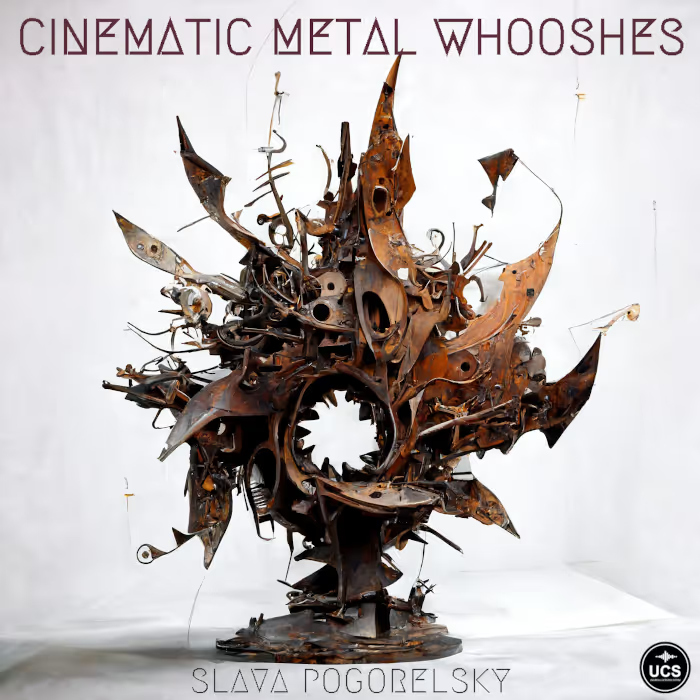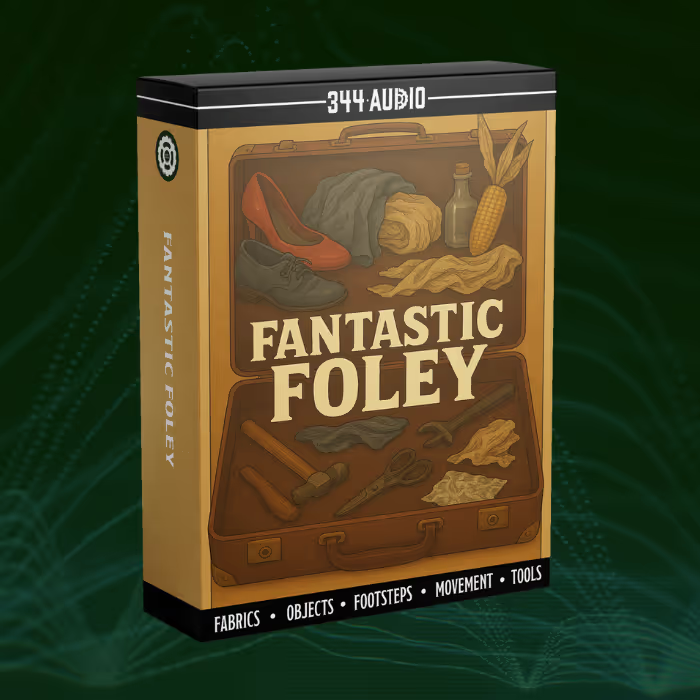HBO’s The Righteous Gemstones has taken a final bow with the conclusion of Season 4, and the show’s crafts teams are leaving on a wave of 2025 Emmy nominations. Among those nominees is the sound editing team on S4, Ep. 1 “Prelude” — Nicholas Renbeck (Supervising Sound Editor), Alexa Zimmerman (Dialogue Editor), Deborah Wallach (Supervising ADR Editor), Rachel Wardell (Sound Effects Editor), Ailin Gong (Foley Editor), Tommy Stang (Foley Artist), and Michael Brake (Music Editor) — for “Outstanding Sound Editing For A Comedy Or Drama Series (Half-Hour).”
Here, they break down their sound work scene-by-scene on “Prelude,” which isn’t the typical Gemstones episode. It’s set during the Civil War — Virginia, 1862. There are gruesome battle scenes and subsequent field surgeries, a lively Confederate army encampment with musicians, blacksmiths, coffin-makers, and trouble-makers, and a tapestry of natural American Southeast summer sounds before modernization and urban sprawl. It’s rustic instead of refined, grimy instead of glitzy — it’s the opposite of the modern Gemstone family way of life portrayed in every other episode in the series. Yet, it still has that same dark humor, Danny McBride’s signature brand of comedy, that made this show so unique.
The Righteous Gemstones Season 4 | Official Trailer | Max
Season 4 of The Righteous Gemstones starts in Virginia, 1862. You can hear a minister giving a sermon and the responses from the congregation. The church interior is appropriately reverberant, so there’s room on their voices. What were some challenges for dialogue on this scene?
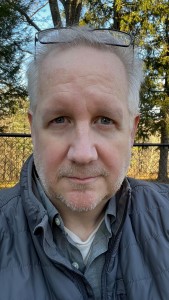
Nicholas Renbeck (NR): Thankfully, we had both the minister and Elijah (Bradley Cooper) covered well with boom and lav mics. There is definitely a live bounce to all the tracks, but thankfully, it’s mostly on the boom and the lavs are minimal when it comes to the natural reverb of the room. Dialogue Editor Alexa (Zimmerman) did a wonderful job cleaning it up before Martin Czembor (dialogue and music re-recording mixer) took over on the stage. We actually ended up leaning into the liveliness of the space, which I think works to the advantage of the scene. This is a church with a good portion of its members gone, at war, or worse (dead). It’s just women, children, and old folks there. There is sadness and loneliness among the congregation members. The minister’s voice bouncing around this half-filled church plays to their situation.
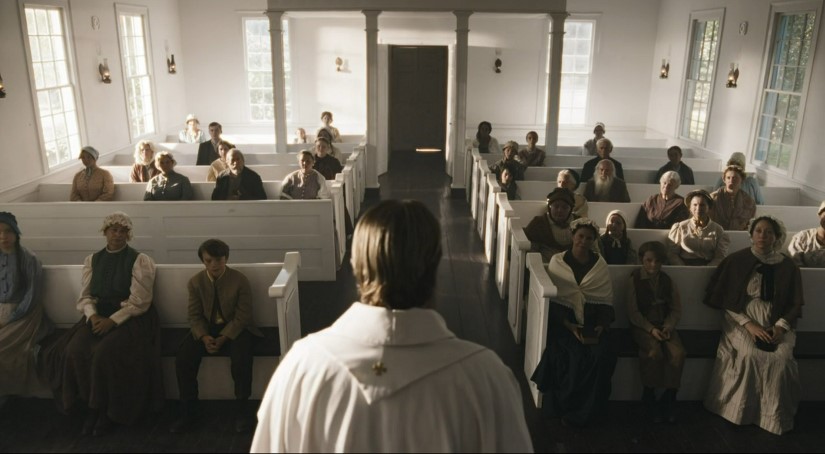
The minister is confronted by a stranger (Elijah Gemstone), who kills and robs the minister. Can you talk about your sound effects work for this scene? (Interestingly, the ringout on the gunfire is less significant than the ringout on the offering plate (and minister) hitting the floor…)
NR: The opening scene in the church, when first watching it, I immediately started thinking about the floorboards of that room. Those old churches have wide, rough-milled floors, held in place with hand-cut square nails. They move as you walk on them, and the nails squeak as the boards shift. You have the boards, the nails, and the shoes, and they all have to work together. So I asked Ailin and Tommy to really focus on that action with our foley, which they did marvelously.
we are playing the space as empty and sad […] In this case, reverb equals sad and lonely.
That was my personal first mental step into that scene and how to approach finding the sound of that space. What to add to that is the next question. The answer is: not much, not while we are inside the church. While the mister is preaching, we have some faint morning birds, wind through leaves, and an isolated cricket, all just poking through to where you can hear them. I had recorded some pew creaks a few years back, which I selectively placed when a small boy shifts his weight in one shot, and also when women start reaching for their purses. When the minister says, “Bring an end to this war…” we get a distant crow call, which I try to keep coming back to as a sonic element as the episode progresses.
As I noted before, we are playing the space as empty and sad. The minister and later, Elijah, are the only people moving in the church, so we lean into their actions and the items they touch. In this case, reverb equals sad and lonely.
The cut to outside the church gives us a large shift in the backgrounds. Now all those faint sounds of nature come forward and spread out in the sound field; our loop group voices kick in here. We add a lot of active footsteps and movement of the congregation leaving. We have wide, off-screen action of horses and wagons panned left, right, and behind the listener. Again, this juxtaposes the lonely, empty inside of the church with the outside world. Once the minister closes the door and we are back inside again, the outside world falls away. We narrow the sound field and begin further leaning into the minister and Elijah’s movement in the empty space.
these decisions for how it’s shot and how it’s edited allow us to create a much more dynamic soundtrack
The way this episode is shot by our DP Paul Daley, and edited by Justin Bourret, it’s a gift to sound. You have these wide-angle shots from above in the church intercut with tight close-up shots of the gun firing, the hand hitting the collection plate, and the coins and plate hitting the floor, which lets us play with sonic perspective in a really fun way. It’s a close-up shot, tight mic-ed/close perspective sound, a little more dry and loud. Then, a wide shot, so we drop the level, and have more reverb. None of this is extremely complicated, but these decisions for how it’s shot and how it’s edited allow us to create a much more dynamic soundtrack. So I appreciate that style of filmmaking.
You noted the change in reverb on the gunshot. It definitely is shorter than the other sounds around it. The reason behind that is two-fold. First, it was a CU shot and it seemed more shocking in its abruptness to keep it short and loud. Second, and more importantly, we needed to make room for the impact sound of the bullet in the Minister’s head to register.

What about the foley for this opening sequence — the creaky floors and podium steps, the sound of the coins, the creaks of the pews, the Elijah looting the minister’s corpse, etc.?

Ailin Gong (AG): This opening sequence marks the very beginning of the Gemstone family’s story. We used designed Foley details to amplify the tension and suspense of this church murder. We made floor and pew creaks with subtle variations — different positions, weights, and intensities to track Elijah’s and the minister’s movements through the space.
The coins were an important story element: the minister’s ill-gotten wealth spilling to the floor with his body, then taken by Elijah as his first pot of gold. We experimented with different coins to find a heavier, more resonant sound to underscore the moment.
Finally, the tactile sounds of looting the corpse were crafted to reveal the golden Bible — the object that sparks this story and echoes through the Gemstone family’s history.
Tommy Stang (TS): Creaky, resonant wooden footsteps are probably my favorite type of foley sound to create! For most projects, the goal is for the foley to sound naturalistic with a touch of hyperrealism. With creaky footsteps, that equation is almost inverted – the more you lean into the exaggerated textures of the groaning, aching floorboards, the more naturalistic it sounds. It’s a fun opportunity to be very maximalist in what is often a very subtle craft. The footsteps here were comprised of two layers – one of me walking on a hollow wooden platform, and the other of creaky wooden floorboards in my house. Ailin Gong did an excellent job of making these two elements sound like one cohesive whole.
It’s a fun opportunity to be very maximalist in what is often a very subtle craft.
Whether it was the churchgoers rifling through their pockets, the preacher counting up the tithes after the service, or the coins and offering plate crashing to the ground, there was an imperative to really foreground money in this scene. The falling of the offering plate after the preacher was shot was a particularly fun opportunity to fill out the reverberant space of the church. It can sometimes be challenging to convey multiple simultaneous actions without things sounding muddy, and the way I tried to avoid that in this moment was leaning into the bright tonal quality that the metal coins have. Doing so freed up the middle and low end of the frequency spectrum for the more muted clattering of the wooden plate and the thumping crash of the preacher’s body. The audience could get this big, cacophonous moment without losing the important textures.
Shaping The Sound of HBO Max’s Emmy-nominated ‘The Righteous Gemstones’
Can you talk about your approach to sound editing the Civil War battle scene, to moving the sound along with the visuals so you get the sense of inescapable horror?
AG: We did quite a lot of foleys to support the sound effects and heighten the chaos of the battle, for example: gun and raffle rattles while running, bridle and saddle movements, bodies falling and being dragged across grass and dirt, the dirt/debris/rocks kicked up by cannon fire, and the splintering of wooden planks.
NR: One of the nice things about working on this episode was we had a bit more time for the sound editing and design than a regular Gemstones episode. Justin was able to send me a few of the bigger scenes while they were still working on the picture cut, and I spent a couple of days doing early passes of the battles and sending back temp mixes for Danny and Justin to review.
This early temp sound work is something that is, of course, common in features, but for series work, that’s not a luxury I’ve had very often. Budget and schedule usually dictate getting in and working fast. On Gemstones, we would normally have 5 days editing for a 30-minute show, then 2 days mixing and a day for review.
as Gemstones’ often has a bit more going on than your standard 30-minute comedy, it can at times be a heavy lift for the crew
For longer-running episodes, we would get a bit more time. In general, though, we get the locked episode, I spot it with Justin, we zone in on what we are going to focus on, the sound crew gets its marching orders, and we try to knock it out. Again, I think this is a pretty standard work timeline for TV shows happening today. But as Gemstones often has a bit more going on than your standard 30-minute comedy, it can at times be a heavy lift for the crew. Thankfully, on this one, we got a bit more editing and an extra day of mixing time to fine-tune things.
Audio interview: The Righteous Gemstones & Pee-wee as Himself
For this first battle scene, it’s a single tracking shot across the Confederate front line as they engage the Union army, which, for the viewer watching on TV, is behind them. As the camera tracks across the Confederate soldiers, they charge forward, firing. The bullets and cannonballs of the Union army rain down upon them. The camera shot starts with a single soldier running across the frame, followed by two men on horses, and then the scene starts ramping up with more soldiers, cannons, and explosions. We really tried to make use of the Dolby Home Atmos set up on this single tracking shot, giving placement to as much of the action as we could.
There was so much on-screen action to cover and so much off-screen action that also needed to be clearly understood
Having the Union cannons firing from behind us, or on the sides of the sound field, was helpful to spell out the action. There was so much on-screen action to cover and so much off-screen action that also needed to be clearly understood. Finding that balance and figuring what sounds to feature was really a fun discovery.
As I’m editing, I’m actively cutting in a 9.1.4 design room, playing through the Dolby Atmos Renderer. It’s become such a wonderful way to work. I’m constantly thinking where I can park these sounds to make this location more interesting for the viewers’ ears. What helps move the scene forward, but does not get in the way of the story? What helps give clarity to the story? What steps up the action as a scene progresses? For something like this battle scene, having the time off the mixing stage to fully plan out the what, when, where, and how each sound is going to play is really the only way we could get this particular episode done within the time window available to us.
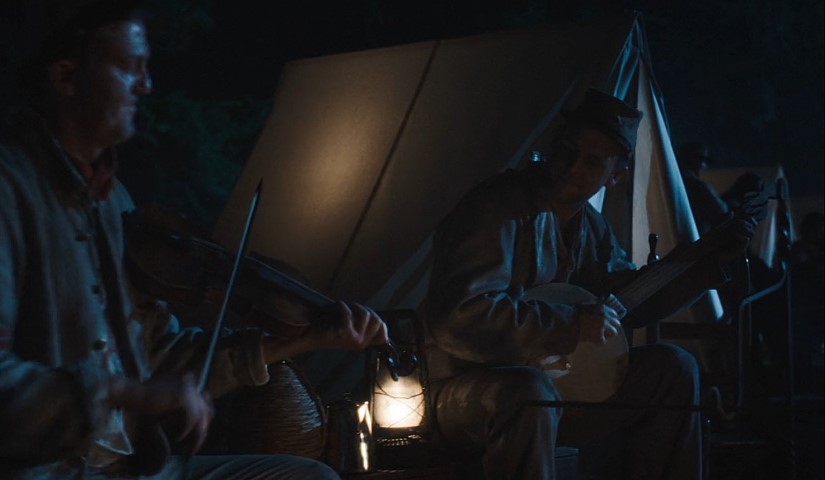
What went into the ambience/backgrounds of the soldiers’ camp? What did you want to express to the audience through these sounds?
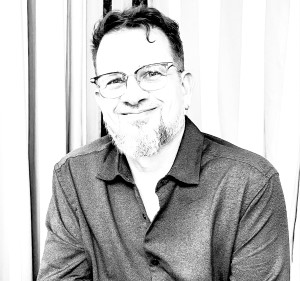
Michael Brake (MB): The musicians around the campfire were absolutely great. This scene looks great, and sounds great. These were handed over to me early on to check sync. The first one looked a good — little bit of a push and pull here and there and the sync was fantastic. The second one was just wrong. The tempo was off. The musicians were obviously playing a faster tempo. I replaced the pre-record track with another, and it looked great in the closer shot, but when we cut to the crane shot, the fiddle player switches from absolutely sawin’ away to long legato notes (probably not the same song, but it was supposed to be). I had to figure out an edit of the song in the three-second mid shot that matched the fiddler sawin’ awat. That led me to the longer melodic part of the fiddle track. It was tricky, but I think it worked well.
NR: We wanted to convey that it’s a busy place. The camp is a world unto itself, with lots of soldiers, nurses, doctors, the injured, all moving about and talking. Add to that horses, wagons, campfires, blacksmiths working on horse shoes, and undertakers building coffins. Then just beyond the wall is the woods, fields, and lake with all its nature full of bugs, birds, wind, and trees. We tried to have all those elements ebb and flow in the background behind the main action. We have moments for things to poke out here and then, but not stay too long and become stale. Each new day we try to introduce a different set of sounds at the camp to keep it fresh and evolving.
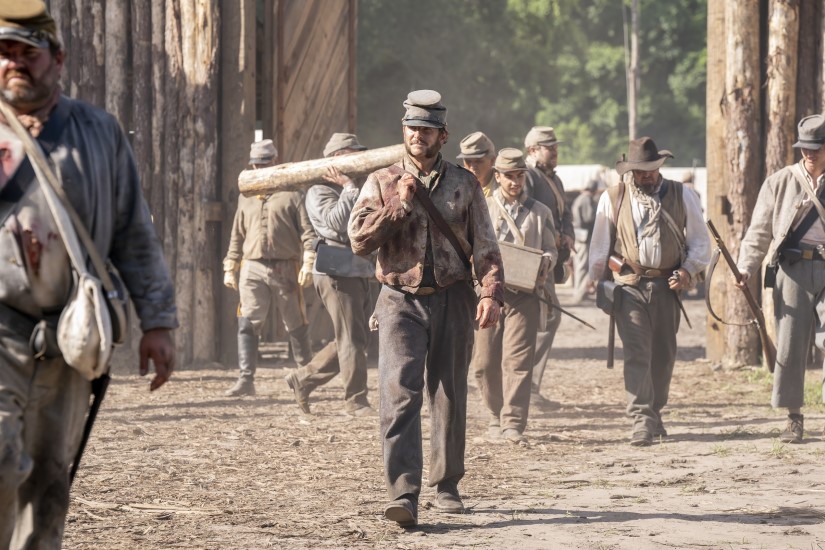
The camp sort of has two sides to it as well: day and night. The light of day has a grim reality of what is happening to everyone, but by night the soldiers are drunk and loud, with music being played as if they are trying to forget the war. The location music in the night time scenes mashed up with abrasive crickets really help shift that world for the camp.
The location music in the night time scenes mashed up with abrasive crickets really help shift that world for the camp
I feel like the group added so much to these scenes. Deborah Wallach, our ADR Supervisor, along with Dann Fink and Daphne Gaines, who ran the loop group, really dialed into that camp. Be it the wailing soldier on the operating table, the many pass-bys of background characters, a nurse checking on an injured man, or the burst of laughter from drunken men at night, all those performances, how Deb placed them, and then how Martin mixed them to sit just-so was an impressive bit of subtleties and shades.
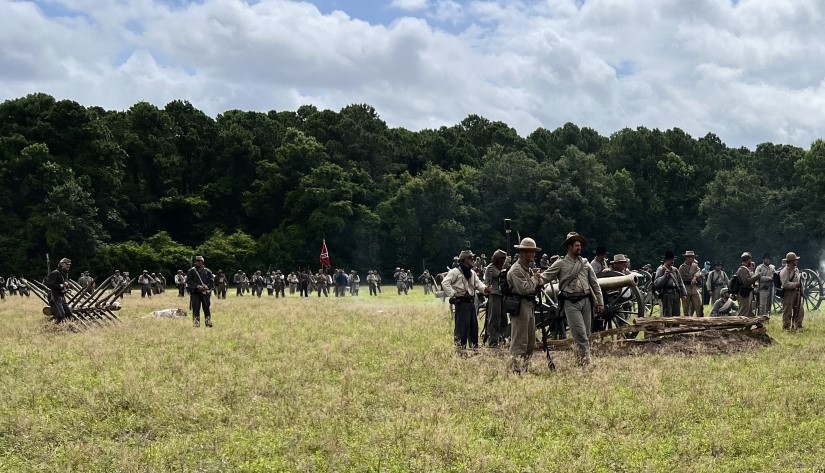
There are large battle scenes and long, active Confederate campsite scenes, which required a lot of loop group. How did you approach the cueing, recording, and building the loop group presence in this episode?
Deborah Wallach (DW): This episode was such a delight, full of attention to detail, which grounded us in a sense of time and place.
In prepping for the loop group recording, I cued for that detail, layering vocals often in an abstract way. For one, the battle scenes would need embellishing to give a sense of movement through the battlefield. I hoped to extend the battle cries for more fluidity. Fortunately, we were able to hire more voice actors for this episode, and Dann Fink and Daphne Gaines did a great job in casting for the Civil War period.
I cued for that detail, layering vocals often in an abstract way. For one, the battle scenes would need embellishing to give a sense of movement through the battlefield
The campsite scenes were the most difficult to keep alive without being distracting because they were so long. I cued for all specifics, but also for many off-camera scenarios that would help me build a textural background that kept the scene alive and not feeling like walla. The soldier in surgery is a good example of how hard it was to record an extended on- and off-camera situation that needed to fit into a certain timing to match Elijah’s reactions and the action we saw. In addition, each of the campsite scenes required a different tone: after battle, evening, the gambling area, preparing for moving on, etc.
We recorded a lot of wild tracks, which I used editorially throughout to enhance moments of tension or surprise
Even for scenes like Elijah’s “mass,” we still need to keep the background activity alive and making sense. The voice actors were exceptional at keeping dialogue fresh and in period language.
We had a similar challenge in recording the scene leading up to the execution of the Confederate soldiers. There is a lot of activity going on around the main characters that the audience needs to feel before we cut to it.
We recorded a lot of wild tracks, which I used editorially throughout to enhance moments of tension or surprise. Detailed editing was crucial in making these tracks effective, and to do it in a way that allowed Martin to do his magic, which he did.
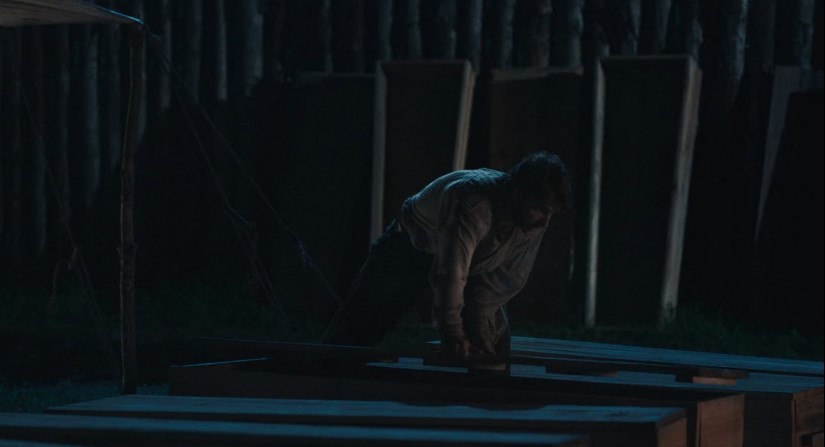
Elijah Gemstone strangles Ned Rollins, drags him out of the tent, and loads him into a coffin. It’s a dark scene, so a lot of information is conveyed through the sound. Can you talk about your sound work for this sequence?
AG: This sequence is full of physical action, so we used foley to underline the movement. For the strangling, we added leather belt rustles and creaks, the wooden chair creaking and tipping over, and tabletop items like glass bottles and a lamp rattling and falling with the struggle, body impacts, and scuffling on grass, etc.
it was important not to go too delicate on the props here, because we want the audience to feel a bit anxious about how brazen Elijah is
As the scene moved to the exterior, we made the sounds of dragging the body across grass, prying open the coffin lid, the creak and squeak of nails being pulled, placing the body inside, and nailing the lid shut again. Each sound was timed to the visuals, carrying the weight and tension of this dark sequence.
TS: One of the fun challenges of this sequence from a foley standpoint is that Elijah is trying to be as stealthy and quiet as possible, but a lot of the things he’s doing, particularly hammering and prying open the coffin, are necessarily pretty noisy activities. I thought it was important not to go too delicate on the props here, because we want the audience to feel a bit anxious about how brazen Elijah is and how close he comes to getting caught.
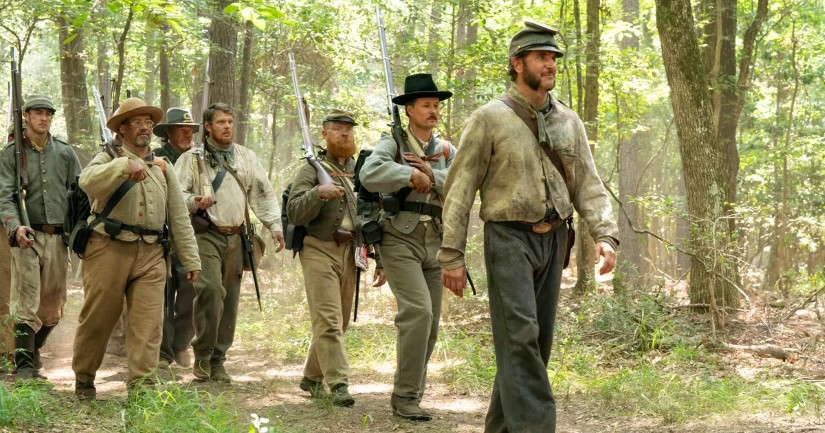
The Confederate army marches through the woods and gets ambushed by Union soldiers. Can you talk about your sound work for this scene?
AG: For the foley, we built the soldiers’ marching footsteps and scattered running steps on dirt and leaves to match the shifting actions. We also made their body impacts, falls, and crawling across the ground, etc. Weapon work included rifle rattles, hits, and loading sounds, along with the sharp, visceral detail of knife stabs — all layered to bring the ambush to life.
TS: The foley footsteps were key to this scene’s dramatic arc. While the army was marching, the footsteps were rather rote and quiet. I tried to give them a calmly mechanistic quality. As soon as the ambush starts, all hell breaks loose, and I tried to underscore that sense of chaos through very frenetic movement, full of stops and starts, sprints forward, then backpedaling, slides, and stumbles and falls.
I had all the splits on the pre-recorded track, so I built different entrances for each instrument
MB: As music editor, when I see musical instruments being played on-camera, I REALLY need to see them played. The musicians played to a pre-record, and I can’t adjust the picture, so I have to adjust the pre-record. It’s gotta look real to feel real. I had all the splits on the pre-recorded track, so I built different entrances for each instrument. Which instruments would you hear at a distance before we really see the band? The trumpet and snare are the loudest of them. Then we get fife, fiddle, and harmonica once we are on the closer shot because they wouldn’t carry as much in real life, so I’ve gotta match that. When we get to the tracking overhead shot of the marching band, the drummer is right up front, but plays a little out of time and hits an extra note here and there. So I need to see it, no matter how short the clip is. I went frame by frame and marked snare hits and adjusted the snare, even on the one really rather off-time note. Reality is built on the smallest details.
NR: This was another section that was a lot of fun to dive into. Again, compliments to our DP Paul Daley, and Justin Bourret, our editor on this scene. I love how we start with a wide shot down the road, with the distant sound of the Confederate army marching towards us. Then we have twelve shots of the army moving through the woods before anyone starts talking. The band is playing as they march; we have close-ups, mids, and wide shots of the men, the horses, the wagon, the band, and marching feet. This picture edit gave us a wonderful opportunity to choose, selectively place, and feature sounds and individual musical instruments that give the soundtrack and location a dynamic feel. Again, leaning into our Atmos sound field, I looked to selectively place the sounds of the forest around these men. A woodpecker starts with the first shot, song birds pop in and out, there is a lot of placement of sounds in the overhead, the wides, and surround speakers.
This picture edit gave us a wonderful opportunity to choose, selectively place, and feature sounds and individual musical instruments that give the soundtrack and location a dynamic feel
Michael Brake did an absolutely amazing job making the pre-record music match the action of those musicians on screen. Nothing matched the original cut. In the back of my mind, I was resigning myself to it at best looking passable, but most likely rubbery with the sync. But Michael really locked all the instruments in. And then my hats off to Martin in his mixing of the tracks; it sits so well with all the perspectives, and moves as each instrument passes by in a given shot. We are talking about maybe 10 seconds of screen time with the musical instruments, but it sells the scene.
Then, of course, we have the battle. Watching the scene, I think we all know this soldier talking with Elijah (Bradley Cooper) is going to get it. He’s getting it first. It’s coming; we just don’t know when or how. I totally love Danny McBride’s direction on this lead-up. He’s just toying with us as viewers — one kind of loves it. And then it happens. A bullet tears right through his jaw, and we are right in the middle of an ambush. We made a conscious decision not to hear the off-camera rifle fire for the bullet; it’s just the impact. The bullet is breaking the sound barrier, getting there before the bang. The impact is surprising enough, so there is no need to hear the shot. Instead, we pivot to the voices of the soldiers as they realize what is happening.
I played up the bullets whizzing by from all sides. The gunshots from the Union soldiers from the surrounding woods played well panned to the side and rear surrounds
I played up the bullets whizzing by from all sides. The gunshots from the Union soldiers from the surrounding woods played well panned to the side and rear surrounds, which allowed space for bullet impacts into men and the wagons as Elijah runs, trying to find cover.
Production voices cover some main call-outs and yells at first, but then production actually sits back more as the group voices jump forward. The way Deborah cut these voices and then Martin mixed them, there’s a throbbing quality to the yells and screams. They sort of punch in and then fall back into a short reverb, actually panning left or right as it goes. It feels like a heartbeat made of voices. It’s so nicely done.

The next step in the scene’s soundscape comes with the two big impacts of cannon balls hitting just behind Elijah. There’s some big low-end on the impact for umph, with dirt spraying out. Elijah dives under a wagon, and we begin to change from the full, in-your-face sound of the battle to a washed-out sound as the camera starts to push in on Elijah’s face. His production track then becomes front and center, his breathing and praying to god sit very close and very dry compared to the verb on the battle. The scene ends with a final big boom, which rings out over the next location.
Danny and Justin had plotted out this idea of the battle falling away as the shot stays tight on Elijah in their picture cut. We had a bit of a challenge as there was actually a good amount of voices from the men fighting behind Elijah on the track. We actually didn’t have access to Bradley Cooper for any looping due to schedules, so we relied on Alexa Zimmerman, our dialogue editor, to surgically get into the production track and clean out much of the background voices. She definitely saved the moment.
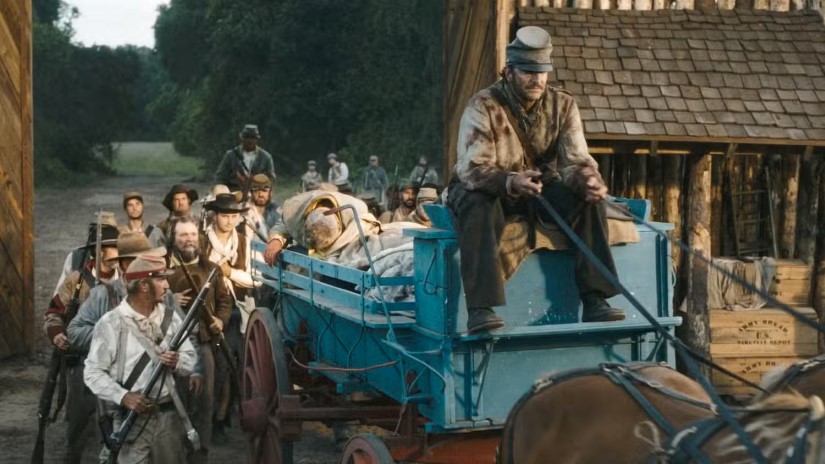
After the execution of the Confederate soldiers, the Union soldiers pack up and leave. Elijah Gemstone hauls the bodies onto the cart. Can you talk about the sound work on this scene?
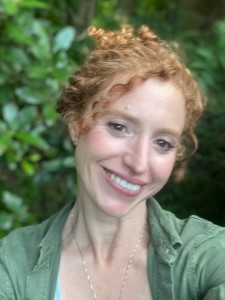
Rachel Wardell (RW): Once again, the music team absolutely knocked it out of the park with this song choice — “For a Day Like Today” by Lee Hazlewood. It’s perfect. Listening to the song on repeat revealed just how deceptively straightforward this scene is. It’s the episode’s pivotal moment and the culmination of the Gemstones’ origin story. The scene subtly highlights the contradictory complexities of human nature. Therefore, the sound design needed to both support this reflective tone and allow the song to take center stage.
Here, Elijah Gemstone — this self-entitled, apathetic yet somehow lovable scoundrel — faces a moment of reckoning and clarity. Whether he’s genuinely changed, merely capitalizing on his newfound talent for preaching, or somewhere in between remains up for debate. That moral ambiguity is a hallmark of The Righteous Gemstones, and it’s a quality we aimed to evoke through the sound design.
That moral ambiguity is a hallmark of ‘The Righteous Gemstones,’ and it’s a quality we aimed to evoke through the sound design.
For example, in the handling of the bodies, he’s not exactly gentle. You hear the crunch of rough terrain as the bodies are dragged, the curt rustle of blindfolds pulled away, the muted thud as they’re crammed into the wagon. None of the sounds are exaggerated, but they’re textured just enough to make you subconsciously wince for a beat.
Then comes the horse-and-wagon ride. As a viewer, you’re almost taken aback by this simple but profoundly beautiful act of compassion and respect. So much is conveyed through Bradley Cooper’s stoic expressions and far-off, pensive glances.
To underscore that introspection, we shaped the individual sonic elements of the wagon, letting perspective shifts highlight different details
To underscore that introspection, we shaped the individual sonic elements of the wagon, letting perspective shifts highlight different details: the creak of wood under strain, the heavy clink of the bridle chain, and the cog-like clunks of the wheel rolling over the dirt road. This was all designed to evoke an almost meditative state. At that point, it felt almost disrespectful to call attention to the jostling of the bodies in transport. Instead, we leaned into the weight of the journey itself, using those natural sounds and subtle low-frequency rumbles to give moments of approach a quiet gravity.
As always, Nick and Martin did an amazing job mixing this scene, giving the various elements their moments to shine. I especially love how they pulled back the effects and backgrounds, letting the music carry the weight for the impromptu funereal procession. Then, with a big clunk, the wagon passes over the gate’s threshold — not to break the emotion but perhaps to subtly announce the arrival of Elijah, this newly righteous man of god… or maybe just a guy seizing an opportunity to build his own mythology.
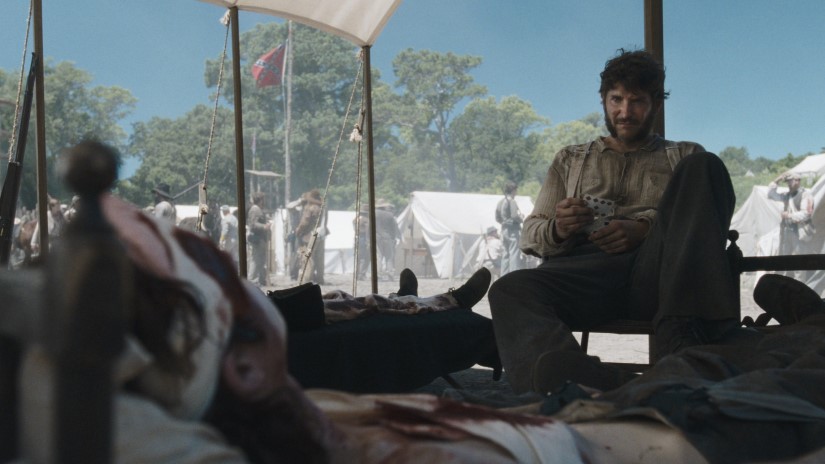
Any helpful indie effects libraries for S4, Ep.1 “Prelude”?
NR:: Actually, yes. After watching the first cut of this episode, I knew I wanted to get some more regional nature sounds from the Southeast. So I popped over to A Sound Effect and picked up the following libraries:
Urban Crows (Detunized)
Summer Ambients (Soundholder)
Nature’s Soundscapes – Organic Sounds of Planet Earth (Epic Stock Media)
Savannah, GA Ambiences (TS Sound)
Nature: Forest Ambience (Gerald Clark Audio)
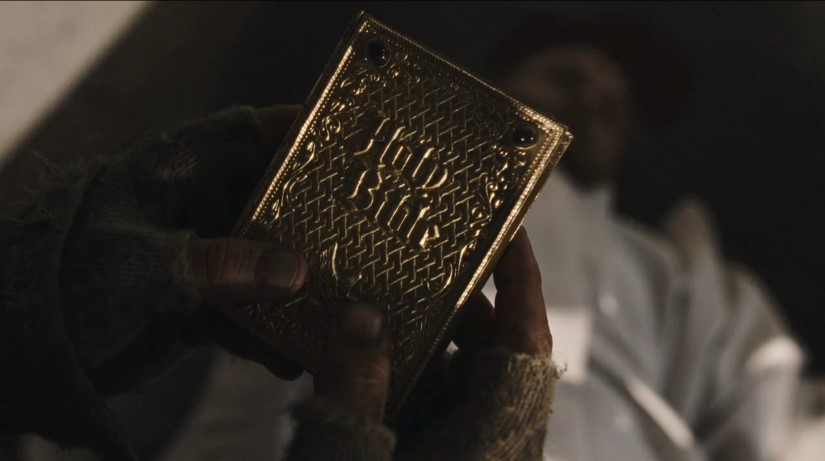
What was your biggest creative challenge for this episode?
TS: Probably the gold-plated bible. It’s a rather simple, straightforward prop, but this episode is the audience’s first introduction to it as it eventually becomes a central element for the whole season. I felt a certain pressure to really give it a sonic signature that could stick with viewers.
As is so often the case with foley, the sounds of this precious object ended up coming from some very mundane items
As is so often the case with foley, the sounds of this precious object ended up coming from some very mundane items. Most of the handling sounds were me interacting with some cheap little daily planner, the page flips were whatever book I was reading at the time, and the metallic touches were from me just putting a half-dollar coin on the cover of the planner and tapping it with my fingers (and in one instance, giving it a big old chomp with my teeth).
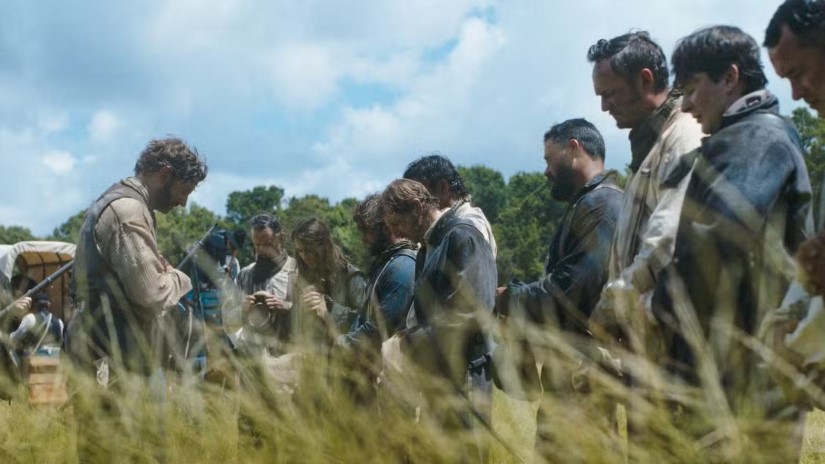
Most challenging scene for editing in”Prelude”?
NR: Surprisingly for me, the most challenging scene was actually when Elijah is giving the final prayer to the men before they are put to death. We start the scene with the wind blowing, hitting the long grass in the field and the trees in the distance, birds singing in the distance, and Union soldiers’ voices. As the prayer starts, our perspective shifts. You have a camera move that is tight on Elijah’s face and then tilts as he is reaching the end of his prayer to show the wind in the trees behind him, and the return of bird song that had been absent during the prayer. Justin and I spoke at length about that sequence, wanting the world to fall away as Elijah finds god in that moment, and when to allow the sounds of nature to come back in on the tilt. It’s a powerful moment in the show. At first glance, you would think that’s a simple section, but in reality, I spent a long time getting it to what you see and hear.
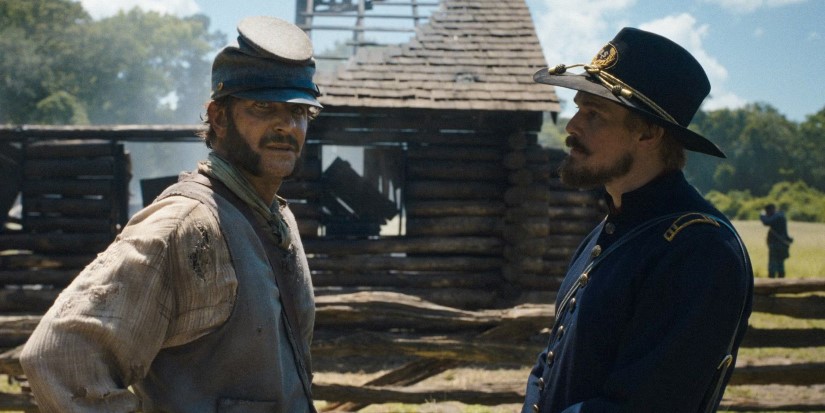
This episode marks a significant departure from the show’s familiar cast and time period. From a sound editing standpoint, did you strive to maintain a sense of cohesion with the rest of the series, or did this shift present an opportunity to take the sound in an entirely new direction?
RW: The Righteous Gemstones has always had a knack for using dark comedy and outrageous stunts to expose the inherent flaws of human nature, only to then really disarm the viewer and upend expectations with a moment of genuine compassion and reflection. So in that sense, the role of sound in this episode felt both familiar and inevitably cohesive. This time, the “stunt” just happened to be: Surprise! Meet ye-old Gemstone — and, by the way, we’re in the Civil War.
You also immediately recognize Danny McBride’s style of humor, so we could take a similar sound design approach to enhancing the timing and weight of the jokes
The backgrounds had to be period-specific, but because we’re in a similar geographic area, there was already a built-in sonic continuity. You also immediately recognize Danny McBride’s style of humor, so we could take a similar sound design approach to enhancing the timing and weight of the jokes.
It’s been such a joy to work on this series, and it’s obvious how much care and attention goes into every aspect of the show. I just hope our mega-church, monster-truck, gator-park, snowmobile, cross-dragging, roller-blading, locust-swarm sound design — and gloriously foul-mouthed dialogue work — in some way helped showcase these lovable, self-entitled hot messes and made you root for these deeply flawed but amazing characters. It’s been a blast.
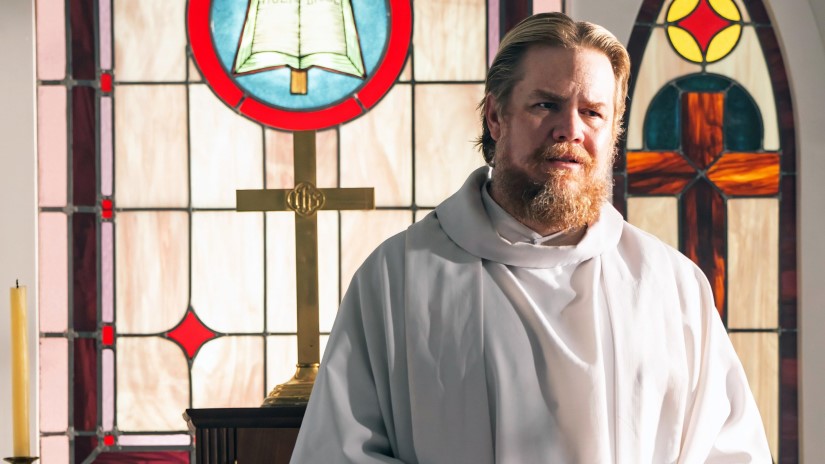
To you, what makes this episode a standout in terms of sound editing? What are you most proud of in terms of your work on S4 Ep.1?
AG: For me, what makes this episode stand out is how much the storytelling relies on sound to build authentic detail and bridge major shifts in time, tone, and setting. We crafted a rich, tactile soundscape that keeps the audience grounded in each moment. I’m proud of how the foley and effects work together to carry emotional weight, making the world feel real, the violence unsettling, and the quieter moments equally charged with tension.
what makes this episode stand out is how much the storytelling relies on sound to build authentic detail and bridge major shifts in time, tone, and setting
TS: There is so much packed into this episode, both narratively and in terms of action, and I think the whole sound team did a phenomenal job at building the textures and depth this episode necessitated while always ensuring that the details that mattered were not lost. I think the team did a great job at creating a sonic landscape that was rich and dynamic without being overwhelming. My biggest point of pride in terms of this episode is having had the opportunity to work alongside such a great and talented team.
MB: For me, the detail in the on-camera music really felt great to me at the end of the day. Like I said before, reality is built on the smallest details. Getting it right keeps the viewers immersed in the story rather than pointing out that the musicians don’t look like they’re playing correctly. There are a lot of great musicians who watch TV, and believe me, it takes us out of the story when we see it. You’re quickly reminded it’s a show. You are un-immersed immediately. So for me, creating the reality of Elijah Gemstone’s world made me incredibly proud.
NR: The Righteous Gemstones has been a huge pleasure for me to work on. Danny McBride has created such a wonderful, rich, silly, and irreverent world that I amazingly got to live in for four stellar seasons. Every episode has presented opportunities to contribute to the ongoing storyline through our work as sound editors and re-recording mixers. I’m very grateful to Danny and to everyone at Rough House for the show they made, to Postworks Sound NY for giving us a home to work out of, and for an amazing sound team that has worked with me on all these episodes.
what we created as a sound team is probably our best overall cohesive sound work of the series
S4, Ep. 1 “Prelude” stands out for me in that I think what we created as a sound team is probably our best overall cohesive sound work of the series. This episode might not have the flashiest sound moments, say like a locus swarm, or a monster truck escape sequence, or a jetpacks mega-church music event, or a memorable clogging dance number with a fantastic catchy song like “Misbehavin” — all of which were tons of fun to get to work on — but I think “Prelude” sonically is the most complete. We were able to fully flesh out all our locations. We were able to find both the big and little moments in this story and give the proper attention to detail that you always want to give to an episode of television yet rarely have the time or budget to do. There is definitely a sense of satisfaction in listening back to this one.
A big thanks to Nicholas Renbeck, Deborah Wallach, Rachel Wardell, Ailin Gong, Tommy Stang, and Michael Brake for giving us a behind-the-scenes look at the sound of The Righteous Gemstones and to Jennifer Walden for the interview!


